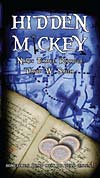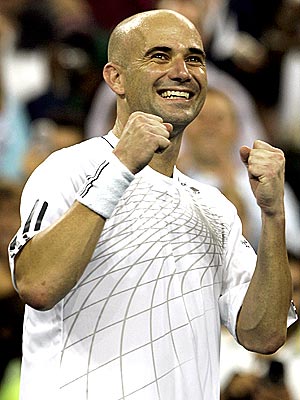|
TennisOne Lessons Winning Doubles: Make it about ThemDavid W. Smith, Senior Editor TennisOne My father, the 1984 California High School Coach of the Year and runner-up National Coach of the Year said something to me about playing tennis that has as much to do about winning today as it did when he told it to me some thirty years ago: "Make your opponent hit the ball one more time." Now, this obvious and incredibly simple adage has nothing to do with stroke production, point management, strategic geometry, nor footwork. Yet, it reminds us that if we hit the ball over the net every single chance we get, eventually our opponent will miss. Many players at all levels often get so caught up in the “how” in regards to hitting a ball, they forget that the point of any rally is to get the ball over the net more than your opponent. We see this a lot at the club level when players miss shots. They often question their technique, grip, footwork and the like. However, in most cases, the player’s aim was simply off. I tell my students that when Roger Federer misses a shot, he doesn’t try to establish or correct a stroke's technical element. It is usually a matter of his focus or simply his aim being off. Certainly, as many of my regular readers will attest, I promote the concept of learning to hit “more effective shots more consistently.” That is, while at lower levels, the simple act of bunting, pushing, dinking, or hacking a ball just to get it over might be enough to win, however, such shots are seldom successful for players compete at higher levels against more effective and skilled opponents. Thus, learning to hit more effective shots will result in opponents having a more difficult time getting the ball over the net. Or, at best, they get the ball over but with a shot that can be put away fairly easily. Too often players try to play tennis beyond their means. That is, they don’t “play within themselves.” In observing thousands of players at all levels, I often see a player execute a great shot and then proceed to miss the next three or four attempts at similar shots. That is because the great shot they made is, in reality, a fairly lucky shot. In other words, they were successful in hitting a shot that is not within their range of consistent success. Winning Doubles This same principle can be seen in many doubles matches. Players often try to do more with the ball than they are consistently able to do. In other words, they try to hit shots which are beyond their skill level which results in many unforced errors.
A great example of this was when I was coaching some very successful teams in California. Our reputation preceded ourselves and most teams would feel like they had to play out of their heads to beat us. I would observe many of these matches and notice that my own players were not playing all that great. But, luckily, our opponents would try and hit shots that were simply not in their range of ability. With such attempts, these opponents would miss numerous shots, allowing my players to win points without having to hit more than a couple of shots at best. Secretly, I often thought that if only these opponents would make my players hit a few more balls, my own players would end up missing soon enough and be beatable…or at least be forced to play at a higher level than they were. Ironically, in many matches where a player upsets a higher-ranked player, it is usually not the case that the weaker player was simply playing out of his head, but that the weaker player was simply getting the ball back enough times to put pressure on his or her opponent. In many cases, the better player has all the pressure of making shots simply because he or she is “expected” to. Melanie Oudin’s great run at this year’s U.S. Open is a classic example of this type of win. In all three of her wins over highly ranked women, she simply outplayed her opponents, but not by hitting a huge number of winners, instead, she stayed in the point long enough to make the better players feel the pressure. She made it about them! When weaker players start off hot, hitting winners early in a match, we almost always see them come down to earth soon enough. It is great to watch Roger Federer patiently wait for players to eventually disintegrate. (Although, give Juan Martin Del Potro all the credit for not falling apart in this years U.S. Open Men’s Final against Fed!) Doubles Mind-set
When playing competitive matches, I try to remind my students (and myself also) to start the match by making the opponent hit the ball as many times as possible. Two things generally happen: Opponents simply make unforced errors early on; or, you gain a sense of confidence that makes hitting better shots at the right time almost automatic. While players, who block tough serves back, hit slicing lower, less flamboyant returns, or lob balls in good situations, don’t appear as flashy as players who try to bang shots back from the start, these players are usually more in control of matches early on. Even if and when opponents hit some big winners against them it usually backfires because, when a player hits a couple big shots in a row – shots they can't consistently control – the player is encouraged to continue with such success. So, when such a player misses a future attempt, he often loses confidence. Instead, when a player plays more conservative, any miss does not seem to carry such a burden of expectation. This happens at the pro level also. In a match at the US open a few years ago between Justin Gimelstob and Andre Agassi, Justin served out of his mind and took the second set after which, he came back down to earth and Andre quickly closed out the match. At the press conference Agassi was asked, what if Justin served the entire match that way? Agassi didn't even hesitate, he said (and I'm paraphrasing), "then he would have been to good. It would have been his day and he would have won match. But... I didn't think he could." And of course, he didn't. Club or League Doubles One of the patterns I see 3.0 and 3.5 doubles players adopt is hitting the same shot over and over! Players rarely, if ever, try a drop shot, a chip shot, or a lob. It's almost as if they were on automatic pilot; they could not think beyond the one shot they are most used to hitting. I believe what makes doubles so much fun is the opportunity to hit many different shots. This ability to differentiate between a wide range of shots and hit in a wide range of circumstances, is what really separates a truly skilled player from just a reasonably good player. Lob Used Offensively My doubles partner, Rick Whittington, recently won the USTA National Doubles title in the 55’s. (I’m not old enough to play in that division!) Rick plays the deuce court and uses a weapon I love to teach: The lob on the deuce court (against right-handed opponents). This shot is exceptional on so many levels, and a shot that is even more effective at lower levels.
But the real issue of this type of lob is that it again puts the pressure on the opponents to have to hit the ball, usually from a defensive position. Yet, it doesn’t require superior power, spin, pace or even stroke technique to execute it well. Conclusion So, next time you're out on the court, make it about them. Look for ways to hit shots that puts the pressure on your opponents. Force them to consistently hit great shots to beat you. You don't have to be a hero out there to play effective tennis. Hitting lower, slicing balls forces opponents hit up on their second shot following a serve. This is ideal for players to switch to attacking mode. Learn to identify when an opponent is in trouble or has to hit a more defensive shot. Too many players hit a great return only to hang back and wait to see what happens. In most cases, opponents are usually in a difficult position to hit an offensive shot and end up simply bunting the ball back over. If you don’t pressure your opponent when they are in this position, then you basically are giving them a “get out of jail free” card to get back into a point. The key here is to develop consistent shots and learn to play within yourself and, most importantly, make it about them. Make them think they have to beat you. More often than not, they won't. Your comments are welcome. Let us know what you think about Dave Smith's article by emailing us here at TennisOne .
HIDDEN MICKEY 
If you are a fan of anything DISNEY, Dave Smith (better known as Senior Editor for TennisOne and author of two prolific tennis books TENNIS MASTERY & COACHING MASTERY), has just published an exciting and compelling novel, HIDDEN MICKEY. This Action-Adventure story centers around three friends who discover a secret journal penned by the master storyteller himself, Walt Disney. The diary hints at hidden treasure and sends the three friends on a wild cross-country search, following intriguing clue after clue and finding incredible discoveries about the great man, his life...and about themselves. For anyone who loves Disneyland or all things Disney, Hidden Mickey is a MUST READ. Limited First Edition, signed and numbered copies, available.
David has taught over 3000 players including many top national and world ranked players. He can be reached at acrpres1@email.msn.com. |

 Your comments are welcome. Let us know what you think about this article by
Your comments are welcome. Let us know what you think about this article by